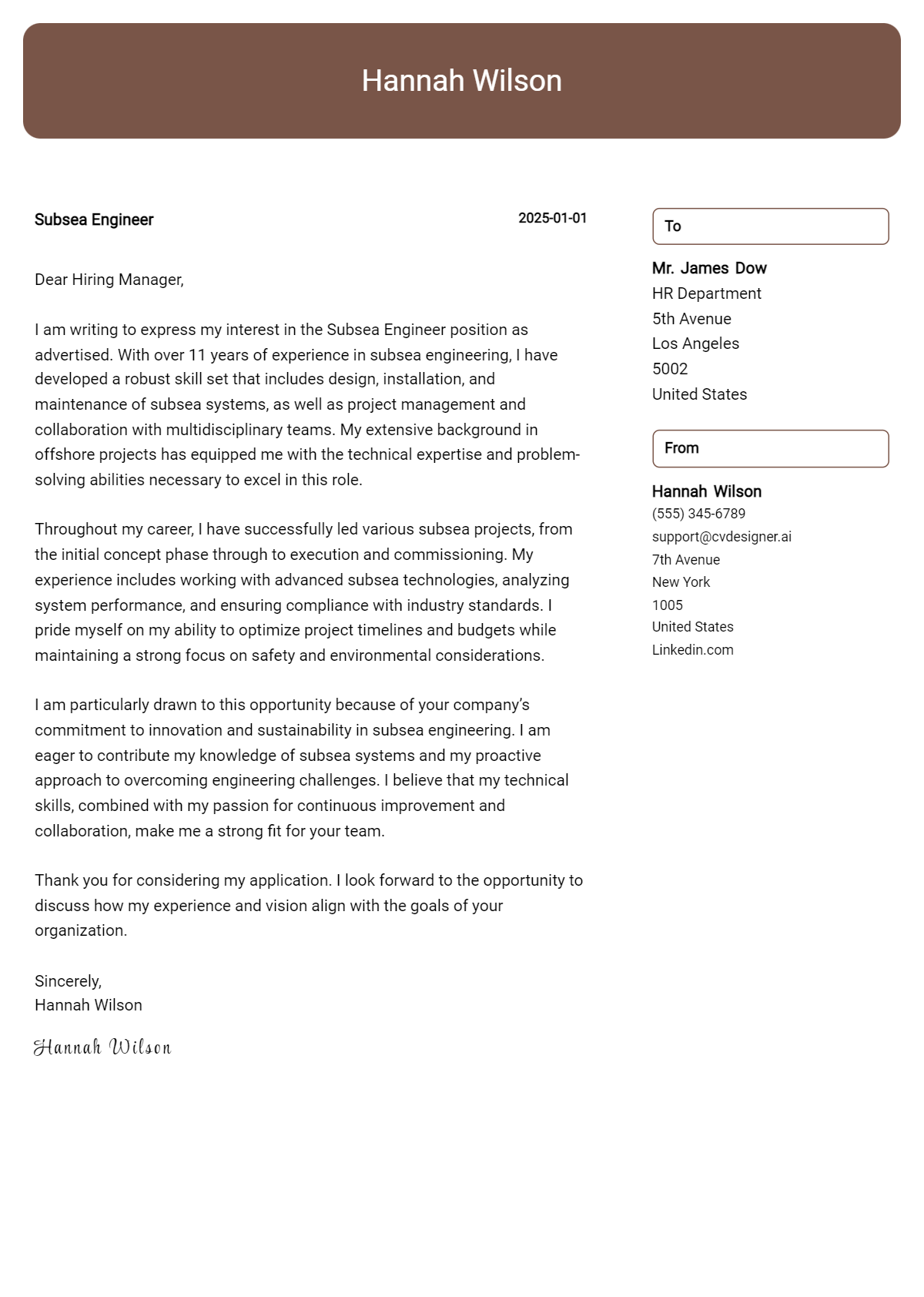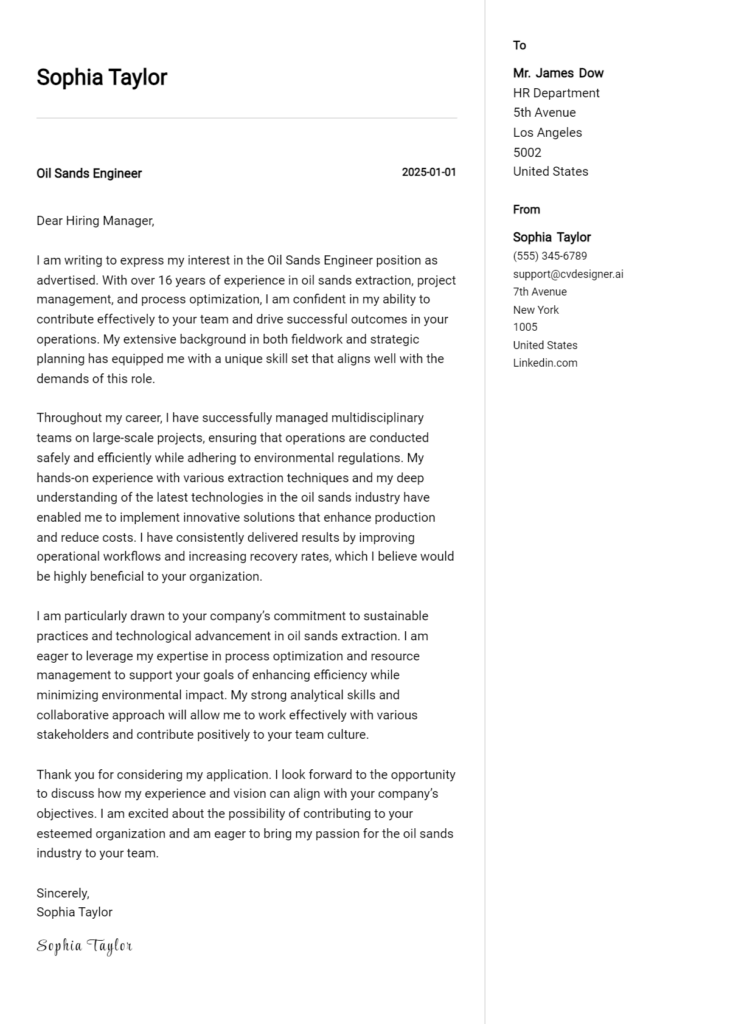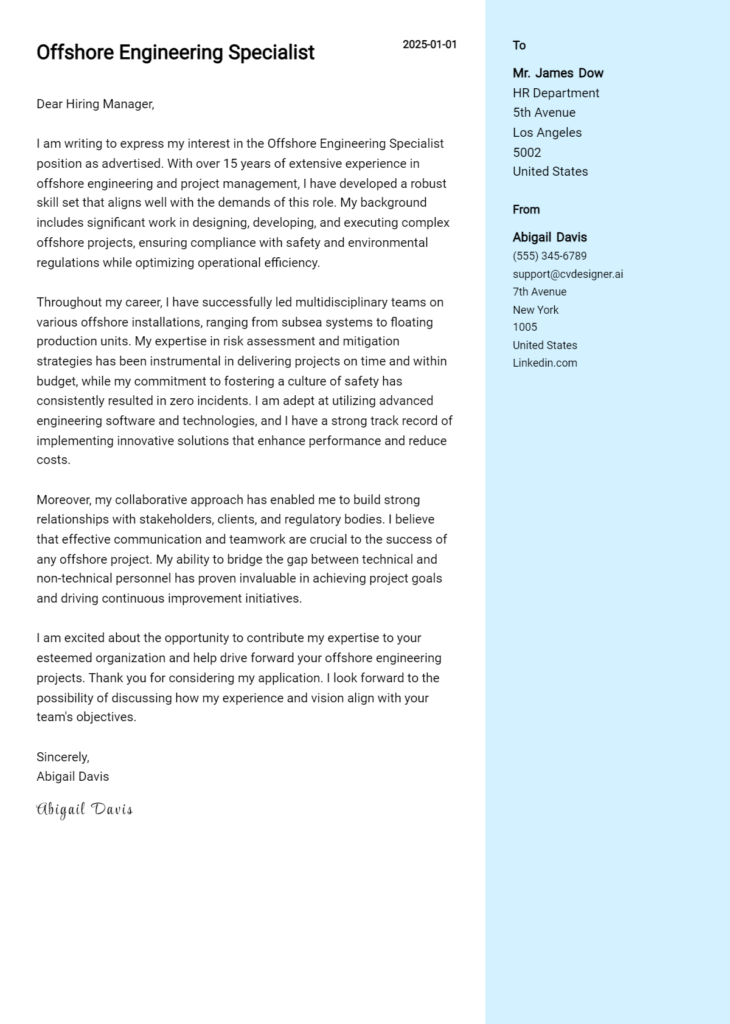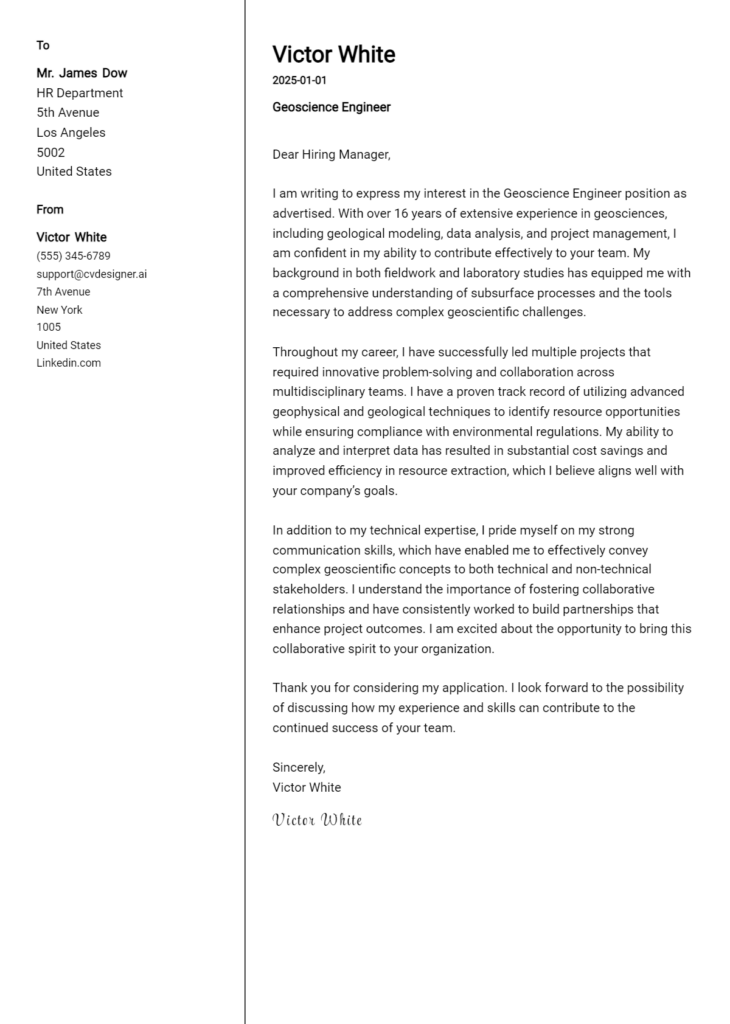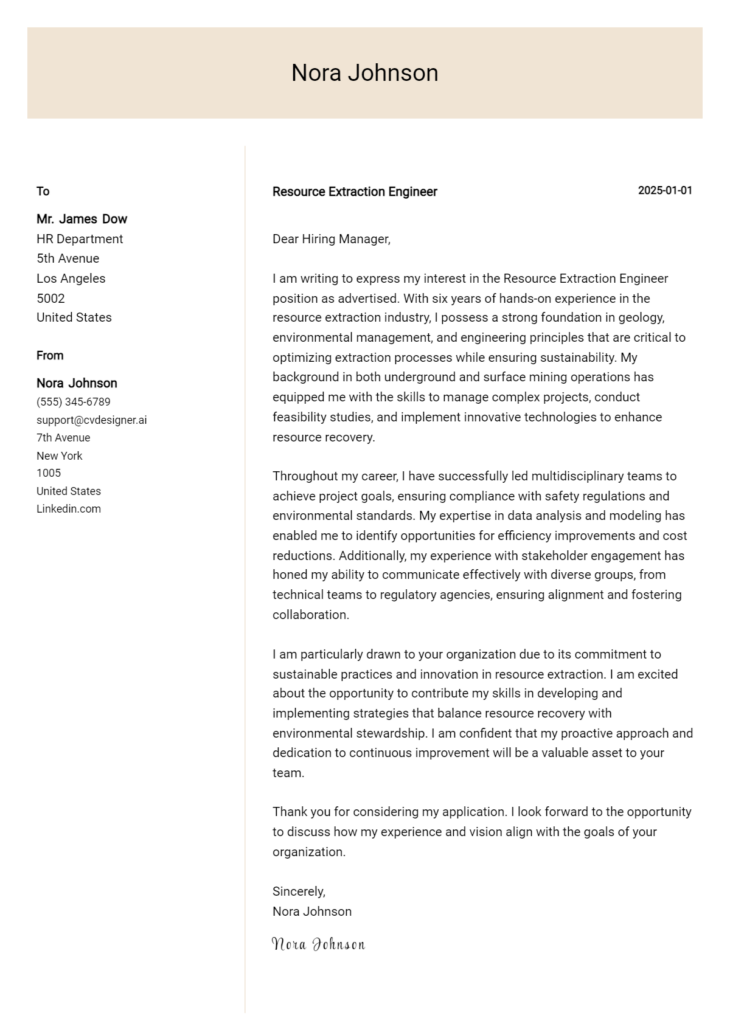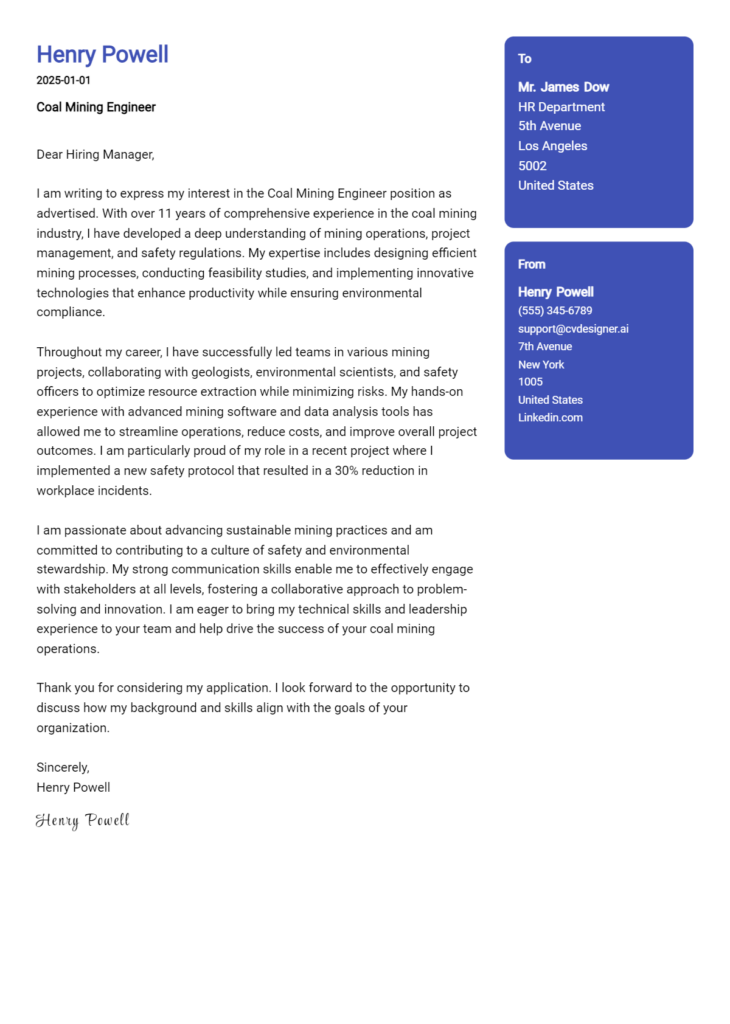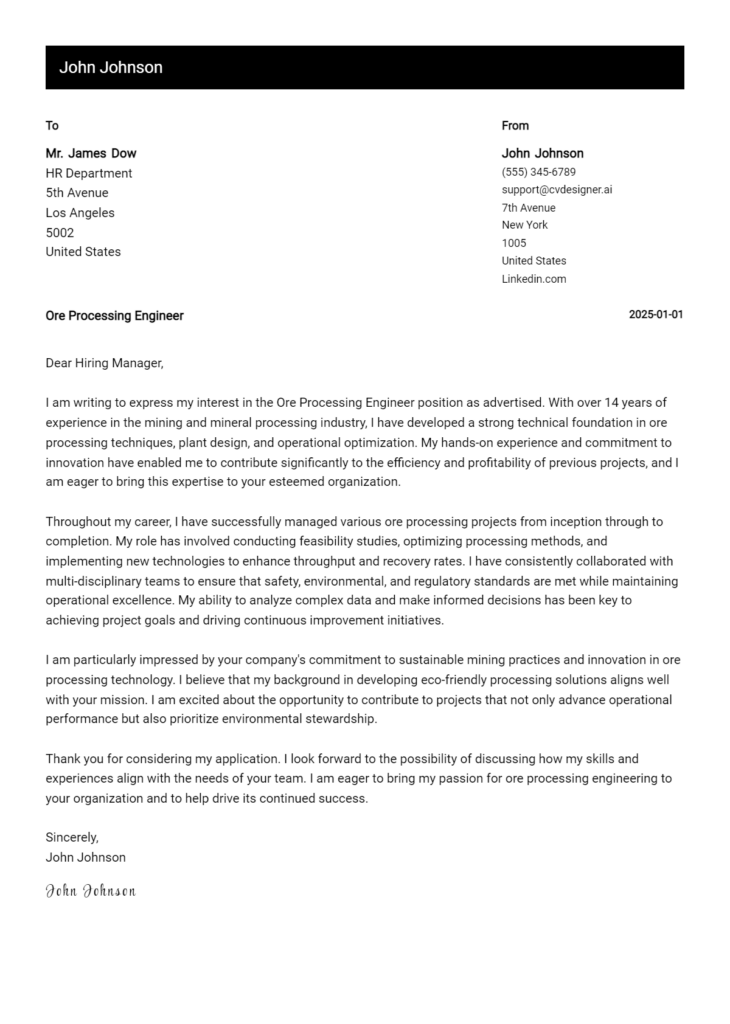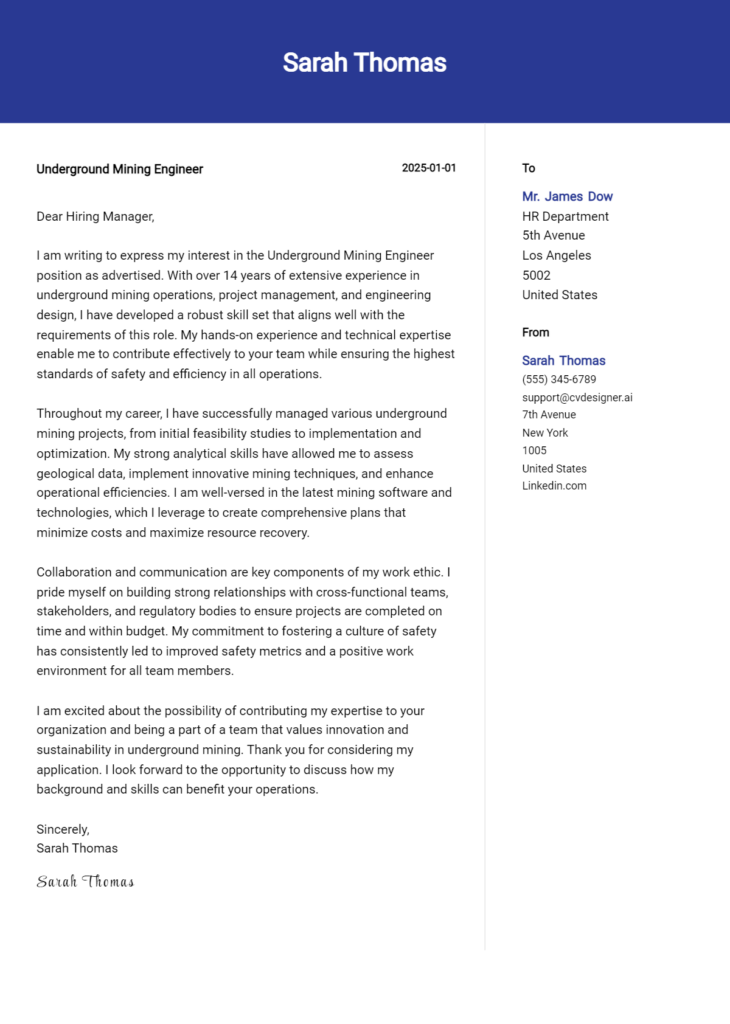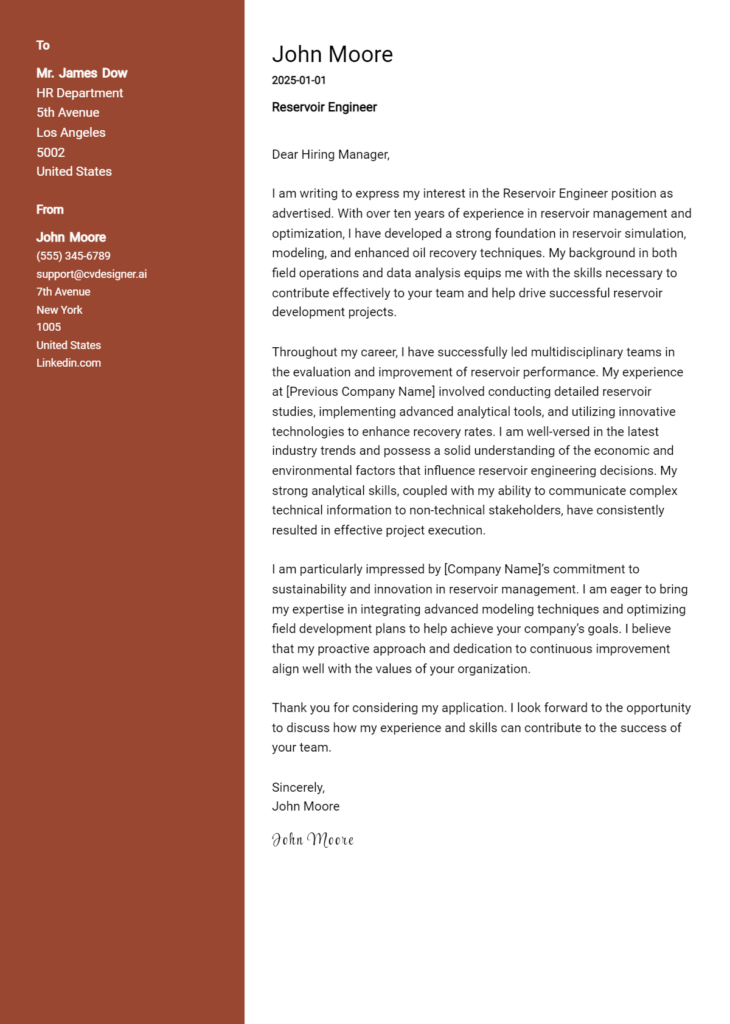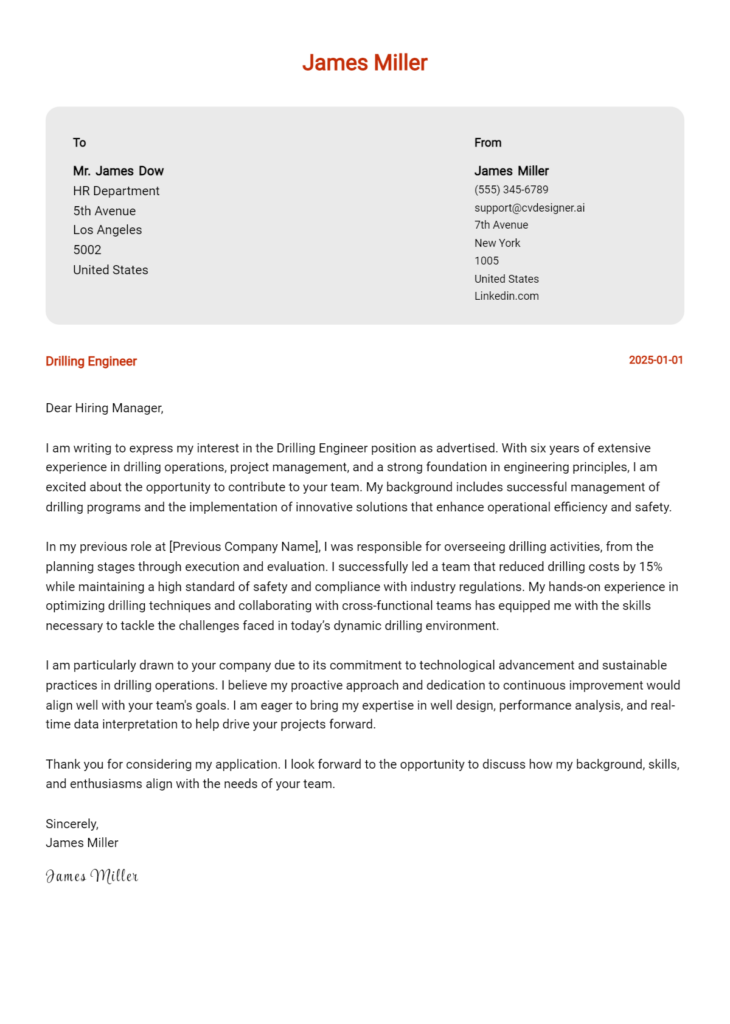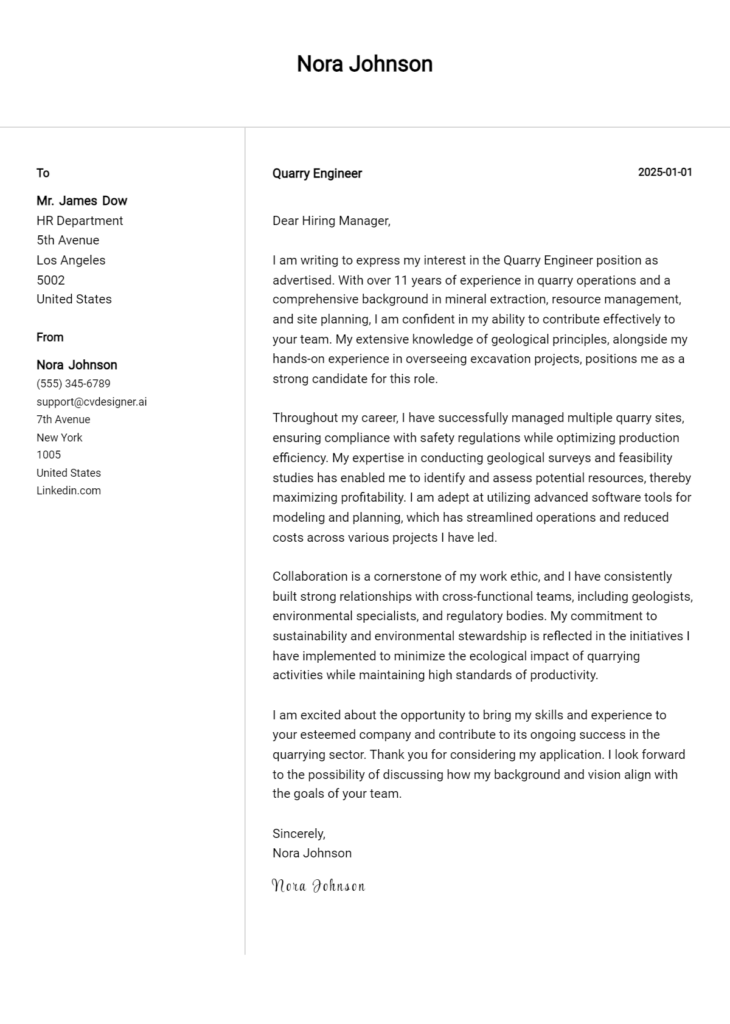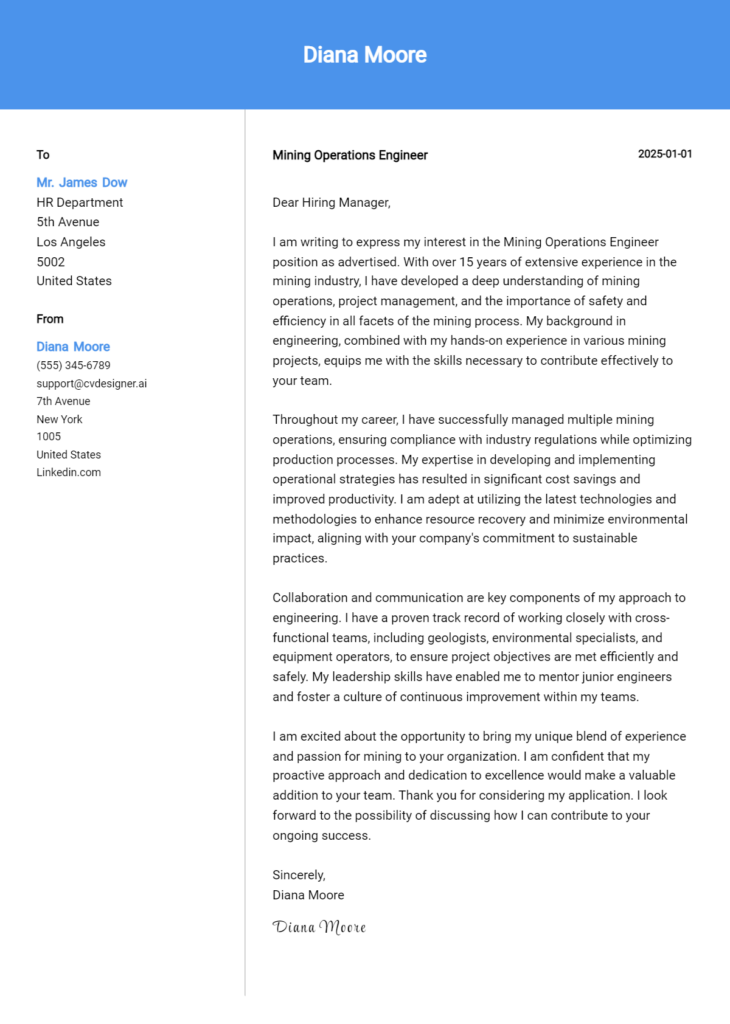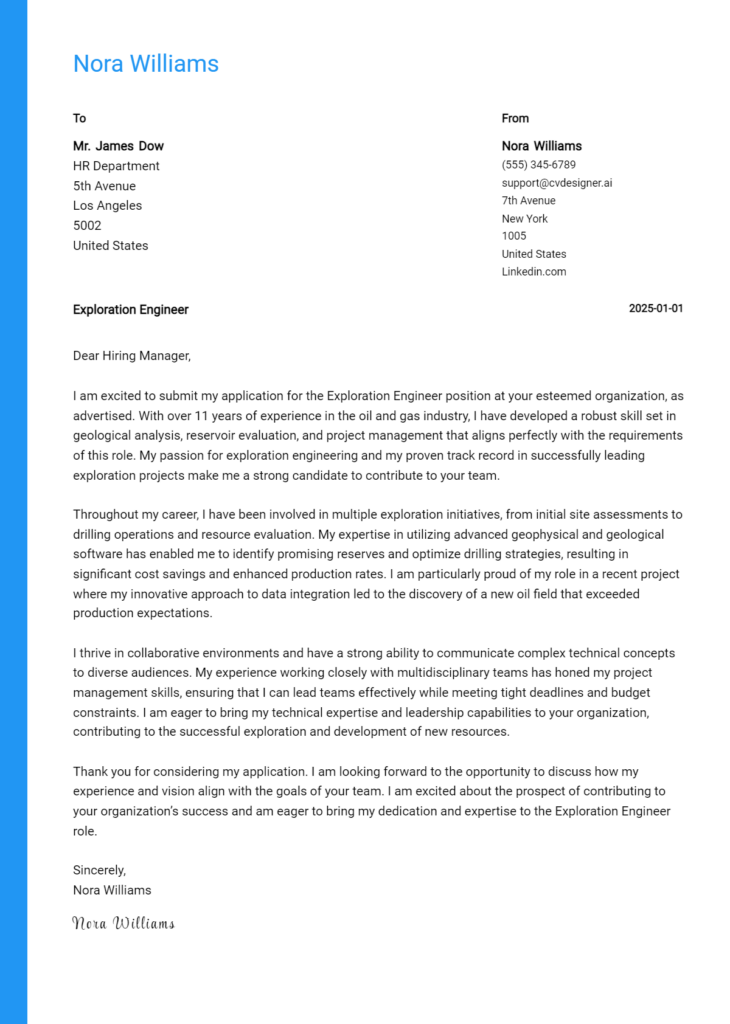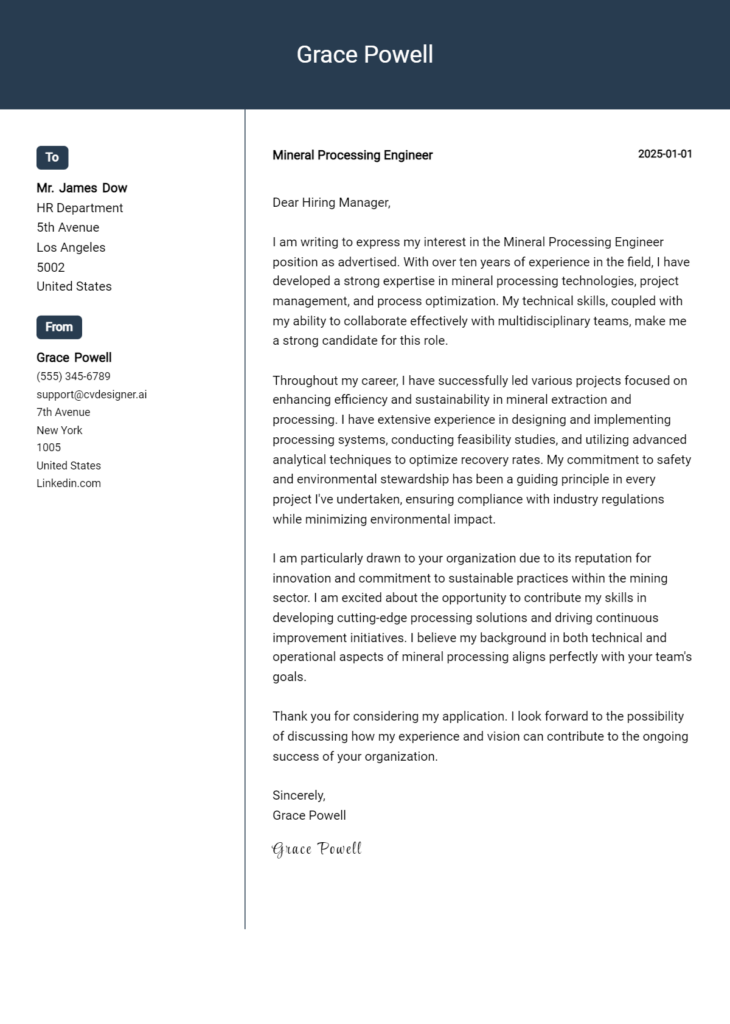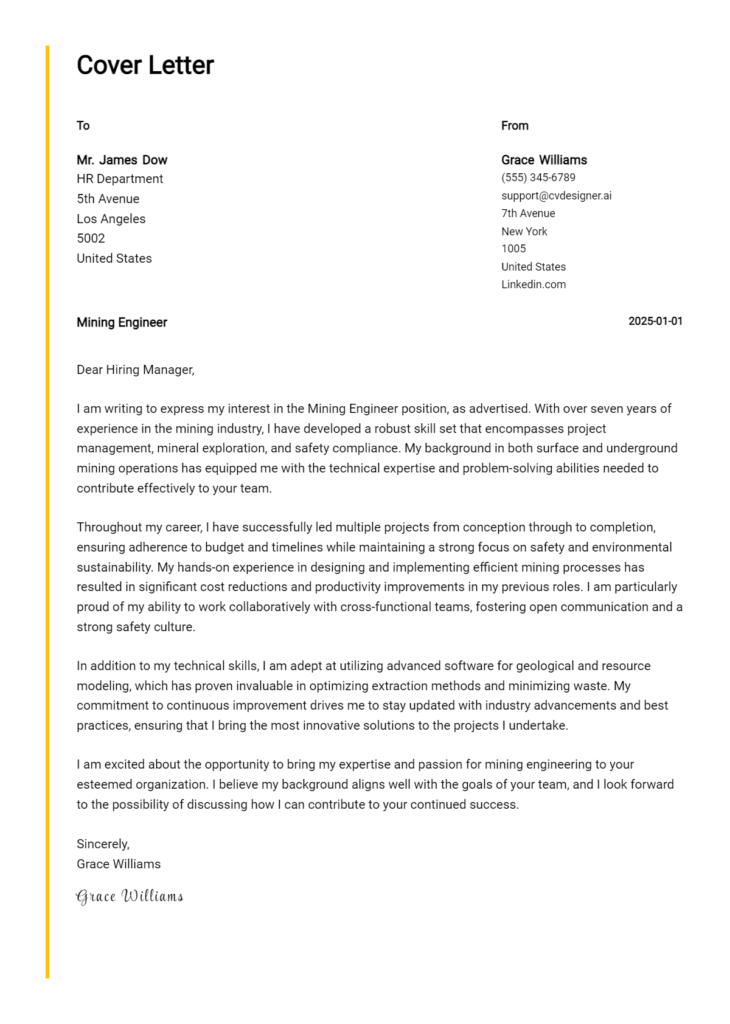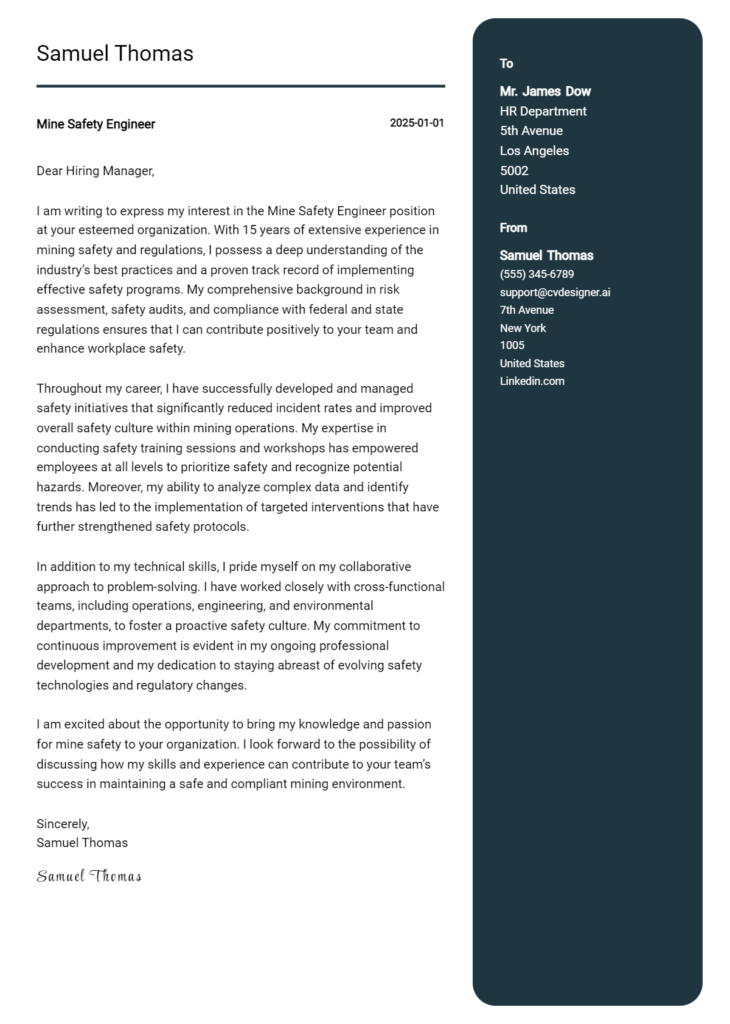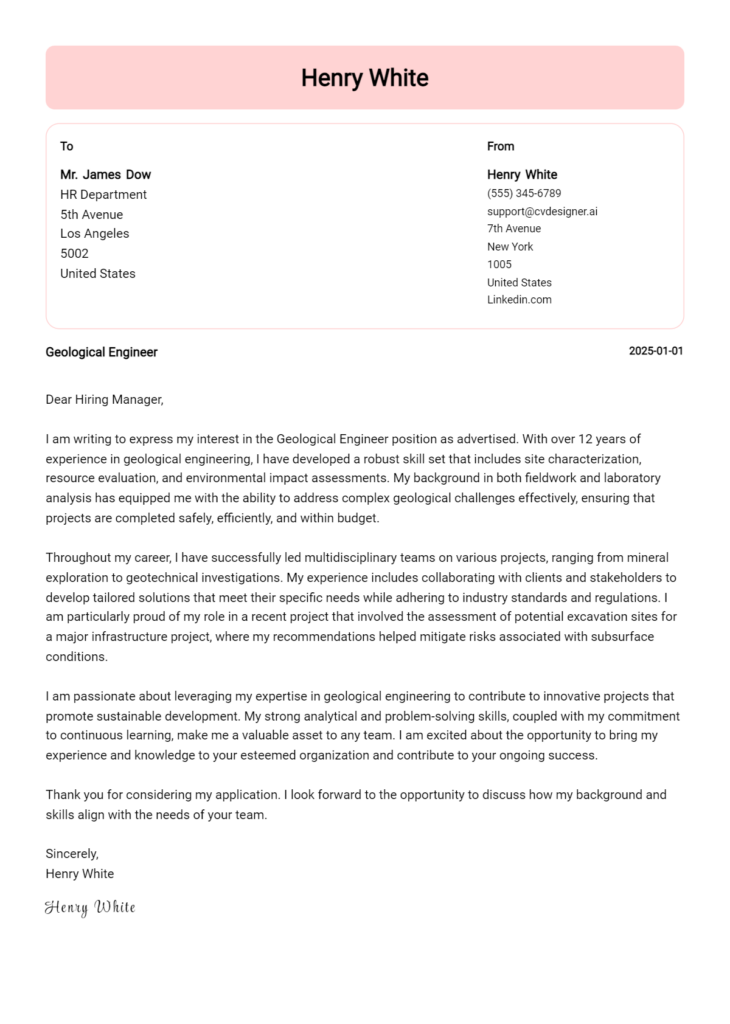Subsea Engineer Cover Letter Examples
Explore additional Subsea Engineer cover letter samples and guides and see what works for your level of experience or role.
How to Format a Subsea Engineer Cover Letter?
Crafting a compelling cover letter is essential for a Subsea Engineer, as it serves as your first opportunity to showcase both your technical expertise and your understanding of the industry. The way you format your cover letter reflects your engineering mindset, attention to detail, and ability to communicate effectively—qualities that are vital in subsea engineering projects. A well-structured cover letter not only captures the hiring manager’s interest but also demonstrates your commitment to professionalism and precision.
In this guide, we’ll explore how to structure your cover letter, providing insights and subsea engineering-specific examples to help you create a standout document.
We will focus on the essential components of a professional cover letter, including:
- Cover Letter Header
- Cover Letter Greeting
- Cover Letter Introduction
- Cover Letter Body
- Cover Letter Closing
Each section plays a crucial role in highlighting your qualifications and expertise. Let’s delve into each part and learn how to make your subsea engineer cover letter shine.
Importance of the Cover Letter Header for a Subsea Engineer
The cover letter header is a crucial element of any professional correspondence, including applications for a Subsea Engineer position. It sets the tone for the rest of the letter and establishes a clear and professional identity for the applicant. A well-organized header should include the applicant's contact information, the date, and the recipient's details, ensuring that the reader can easily identify who the letter is from and to whom it is addressed. Clarity and professionalism in the header not only reflect the applicant's attention to detail but also demonstrate their seriousness about the position.
A strong header is neatly formatted and includes all necessary information, while a weak header may lack essential details, appear cluttered, or be unprofessional in presentation.
Strong Example
John Smith 123 Ocean Drive Houston, TX 77001 john.smith@email.com (123) 456-7890 October 10, 2023 Jane Doe Hiring Manager Global Subsea Solutions 456 Marine Blvd Dallas, TX 75201
Weak Example
John S. 123 Ocean Dr. 10/10/23 To Whom It May Concern
The Importance of the Cover Letter Greeting for a Subsea Engineer
The greeting of your cover letter is more than just a polite introduction; it sets the stage for the rest of your letter and establishes your professionalism and attention to detail. A well-crafted greeting not only demonstrates your respect for the hiring manager but also showcases your effort to personalize your application. Addressing the recipient directly indicates that you have researched the company and are genuinely interested in the position. To avoid generic greetings that can make your letter feel impersonal, take the time to find out the hiring manager's name. If their name is not readily available, consider using a title or department instead. This small effort can make a significant difference in how your application is perceived.
Strong Example
Dear Mr. Smith,
Weak Example
To Whom It May Concern,
The Importance of a Well-Crafted Cover Letter Introduction for a Subsea Engineer
A well-crafted cover letter introduction is essential for a Subsea Engineer, as it serves as the first impression a candidate makes on the hiring manager. In this competitive field, capturing attention right from the start can set the tone for the rest of the application. The introduction should not only express genuine interest in the role but also highlight key skills and achievements that align with the job requirements. A strong introduction can differentiate a candidate from others, showcasing their value and expertise in subsea engineering. Below are examples of both strong and weak cover letter introductions to illustrate the difference.
Strong Example
Dear Hiring Manager, I am excited to apply for the Subsea Engineer position at [Company Name] as advertised on [Job Board]. With over five years of experience in designing and implementing subsea systems, coupled with my recent project that successfully reduced operational costs by 20% while enhancing system reliability, I am eager to bring my expertise to your innovative team. My passion for underwater technology and commitment to safety and efficiency align perfectly with [Company Name]'s mission to lead advancements in subsea engineering.
Weak Example
To Whom It May Concern, I am writing to apply for the Subsea Engineer job. I have some experience in engineering and think I could be a good fit for the role. I hope to contribute to your company in some way.
Cover Letter Body for Subsea Engineer
The body of a cover letter for a Subsea Engineer plays a crucial role in presenting the candidate's technical expertise, relevant experiences, and overall value to potential employers. It allows the applicant to highlight specific projects, accomplishments, and skills that demonstrate their capability to handle the demands of subsea engineering. By detailing experiences such as successful project completions, innovative solutions to engineering challenges, or contributions to safety improvements, the candidate can effectively convey their fit for the role and the potential impact they can have on the company’s operations and objectives.
Strong Example
Dear [Hiring Manager's Name], I am excited to apply for the Subsea Engineer position at [Company Name], as advertised. With over five years of experience in subsea systems design and implementation, I have successfully led multiple projects, including the installation of a subsea pipeline that reduced operational costs by 20% through innovative trenching techniques. My role in the [Specific Project Name] involved collaborating with cross-functional teams to develop a subsea monitoring system that improved data collection efficiency by 30%. My technical proficiency in ROV operations and my commitment to adhering to safety protocols have consistently resulted in zero incidents on my projects. I am eager to bring my expertise in subsea engineering to [Company Name] and contribute to your continued success in the industry. Sincerely, [Your Name]
Weak Example
Dear [Hiring Manager's Name], I am writing to apply for the Subsea Engineer position at [Company Name]. I have some experience in subsea engineering and have worked on a few projects. One of my previous roles involved working on pipelines, but I didn’t really lead any projects. I think I could be a good fit for your company because I am a hard worker and willing to learn. I hope to gain more experience and grow in this position. Best regards, [Your Name]
Importance of the Cover Letter Closing for a Subsea Engineer
The closing paragraph of a cover letter is crucial as it serves to summarize your qualifications, reiterate your enthusiasm for the position, and prompt the hiring manager to take the next steps in the recruitment process. A strong closing leaves a lasting impression and reinforces your suitability for the role, while a weak closing may miss the opportunity to convey your eagerness and professionalism.
Strong Example
Thank you for considering my application for the Subsea Engineer position. With my extensive experience in subsea systems design and my passion for innovative engineering solutions, I am excited about the opportunity to contribute to your team. I look forward to discussing my qualifications further and am eager to explore how I can help drive your projects to success. Please feel free to review my attached resume, and I hope to schedule an interview soon.
Weak Example
Thanks for reading my cover letter. I think I'm a good fit for the job. Please look at my resume if you want. Let me know if you want to talk.
Crafting an effective cover letter for a Subsea Engineer position is crucial in distinguishing yourself in a competitive job market. A well-written cover letter allows you to articulate your technical expertise, problem-solving capabilities, and teamwork skills while demonstrating your passion for the field and commitment to continuous learning. By emphasizing these attributes, you can create a compelling narrative that complements your resume. Here are some tips to help you write an impactful cover letter.
Tips for Writing a Subsea Engineer Cover Letter
Highlight Technical Skills
Clearly outline your technical skills relevant to subsea engineering, such as proficiency in design software or knowledge of underwater construction techniques. Mention specific tools and technologies you have experience with, as this demonstrates your readiness to tackle the technical challenges of the role.Showcase Problem-Solving Abilities
Use examples from past projects to illustrate how you've successfully resolved complex engineering problems. Describe the challenges you faced, the steps you took to address them, and the positive outcomes that resulted. This not only highlights your analytical skills but also shows your ability to think critically under pressure.Demonstrate Knowledge of the Software Development Life Cycle (SDLC)
If applicable, discuss your familiarity with the SDLC and how it relates to subsea engineering projects. Mention any experience you have with project management methodologies, as this showcases your ability to manage projects efficiently and collaborate with interdisciplinary teams.Emphasize Teamwork and Collaboration
Subsea engineering often involves working in teams composed of diverse professionals. Highlight your experience in collaborative environments, focusing on how you contributed to team success and maintained effective communication. This can help potential employers see you as a valuable team member who can foster a positive work atmosphere.Express a Passion for Continuous Learning
The field of subsea engineering is constantly evolving, and showcasing your commitment to professional development can set you apart. Mention any relevant certifications, courses, or conferences you’ve attended that demonstrate your dedication to staying current with industry trends and technologies. This illustrates your proactive approach to career growth.
By following these tips, you can create a standout cover letter that effectively communicates your qualifications for a Subsea Engineer position. For additional resources, consider exploring our cover letter templates or utilize a cover letter builder to streamline your writing process.
Common Mistakes to Avoid in a Subsea Engineer Cover Letter
Avoiding common mistakes in your cover letter is crucial for standing out in the competitive field of subsea engineering. A well-crafted cover letter can significantly enhance your chances of landing an interview, while errors can undermine your credibility. Here are some common pitfalls to watch out for:
- Generic Content: Failing to personalize your cover letter can make you seem uninterested. Always tailor your letter to the specific job and company.
- Lengthy Paragraphs: Long blocks of text can be overwhelming. Use concise paragraphs and bullet points to enhance readability.
- Ignoring Keywords: Not incorporating relevant keywords from the job description can lead to your application being overlooked. Make sure to align your skills with the requirements.
- Neglecting Formatting: A poor format can distract from your content. Follow a professional cover letter format to ensure clarity and structure.
- Spelling and Grammar Errors: Typos can give a negative impression. Always proofread your letter or consider using tools for grammar checks.
- Lack of Specific Examples: Vague statements about your experience won't impress hiring managers. Include specific examples of your achievements and skills.
- Failing to Express Enthusiasm: Not conveying your passion for the industry and the role can make your application forgettable. Make sure to express genuine interest in the position.
By avoiding these mistakes and referring to cover letter examples for inspiration, you can create a compelling narrative that showcases your qualifications as a subsea engineer.
Cover Letter FAQs for Subsea Engineer
What should I include in my cover letter for a Subsea Engineer position?
In your cover letter for a Subsea Engineer position, you should focus on highlighting your technical skills, relevant experience, and specific projects that demonstrate your capabilities. Start with a brief introduction that states the position you’re applying for and how you learned about it. In the body, mention your educational background, particularly any degrees related to engineering, subsea technologies, or marine engineering. Highlight your experience with subsea equipment, ROVs, and underwater construction. Don’t forget to include soft skills like teamwork and problem-solving, along with any certifications relevant to the industry, such as IMCA or similar. Conclude with a strong closing statement expressing your enthusiasm for the role and your desire to contribute to the company.
How can I tailor my cover letter for a specific company in the subsea engineering field?
To tailor your cover letter for a specific company, research the organization’s mission, recent projects, and its culture. Start by referencing the company’s values and how they align with your professional goals and experiences. Highlight any relevant projects or technologies that the company is known for and explain how your background can contribute to their success in those areas. Use specific keywords from the job description to demonstrate that you possess the skills they are seeking. Additionally, if you have any connections to the company or have been involved in similar projects, mention them to establish credibility. Personalized cover letters show that you’ve done your homework and are genuinely interested in being part of the team.
How long should my cover letter be for a Subsea Engineer role?
Your cover letter for a Subsea Engineer role should ideally be one page long, consisting of three to four paragraphs. While brevity is important, ensure that you cover all key points effectively. Start with an engaging introduction, followed by two or three concise paragraphs outlining your qualifications, experience, and skills relevant to the position. Use bullet points to emphasize critical achievements or projects if necessary, but keep it succinct. The conclusion should reiterate your enthusiasm for the role and your willingness to discuss your application further. Aim for clarity and focus; hiring managers typically appreciate a well-structured letter that can be quickly scanned while still providing enough detail to convey your value.
What common mistakes should I avoid in my cover letter for a Subsea Engineer job?
Common mistakes to avoid in your cover letter include being overly generic, using jargon without context, and failing to proofread. Avoid using a one-size-fits-all approach; instead, tailor each cover letter to the specific role and company. Steering clear of excessive technical jargon without explanation is crucial, as it can alienate non-technical readers. Ensure your letter is free of grammatical errors and typos, as these can create a negative impression. Additionally, don’t focus solely on your technical skills; emphasize soft skills and teamwork experiences, which are equally important in a collaborative field like subsea engineering. Lastly, avoid repeating your resume verbatim; instead, use the cover letter to tell your story and highlight your most relevant achievements.
Build your Cover Letter in minutes
Use an AI-powered cover letter builder and have your letter done in 5 minutes. Just select your template and our software will guide you through the process.

